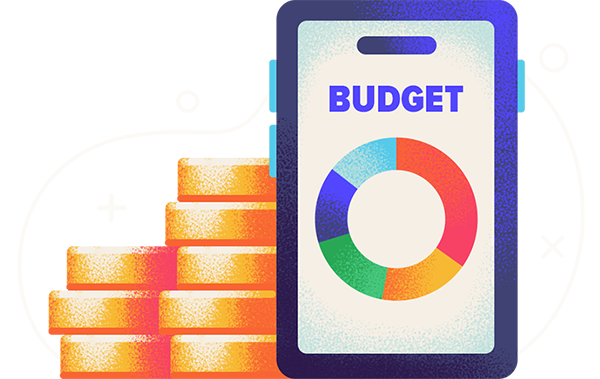Having a well-planned budget that you stick to is one of the most important ways to improve your finances. When you make a budget, you get to plan out exactly how you use your income, which ensures that essential bills get taken care of first and helps you work toward financial goals like building an emergency fund, paying down debt, or saving for a big purchase.
In order to find out where Americans have the best budgeting habits, WalletHub compared more than 2,800 counties based on 11 key metrics, ranging from the share of households without a bank account to the credit card delinquency rate to the share of households with zero net worth.

Chip Lupo, WalletHub Analyst
To ensure that your financial life is as successful as possible, you will need to do more than just create a budget. You’ll also need to track it on a daily or weekly basis to make sure you stick to your plan. If you do that, you’ll maximize your chances of being among the best budgeters in America.
Main Findings
Counties With the Best & Worst Budgeters
*Best = 99th Percentile
With the exception of “Total Score,” the columns in the table above depict the relative rank of each county, where a rank of 1 represents the best conditions for that category.

- Lowest
- 1. Los Alamos, NM
- 2. Falls Church, VA
- 3. Stillwater, MT
- 4. Warren, IN
- T-5. Douglas, CO
- T-5. Fairfax, VA

- Highest
- T-2826. Bronx, NY
- T-2826. Starr, TX
- T-2826. Tunica, MS
- 2829. Wolfe, KY
- 2830. Holmes, MS

- Lowest
- 1. Washington, AL
- T-2. Assumption, LA
- T-2. Johnson, IL
- T-2. King and Queen, VA
- T-5. Carter, KY
- T-5. Morgan, WV

- Highest
- T-2826. Petersburg, VA
- T-2826. Quitman, MS
- T-2828. Tunica, MS
- T-2828. Chattahoochee, GA
- 2830. Bronx, NY

- Lowest
- T-1. Bethel, AK
- T-1. North Slope, AK
- T-1. Rosebud, MT
- 4. Winneshiek, IA
- 5. Hardin, IA

- Highest
- T-2815. Houston, AL
- T-2815. Shelby, TN
- T-2815. Chambers, AL
- T-2815. Butler, AL
- T-2815. Lowndes, AL

- Lowest
- 1. Johnson, KS
- 2. Tippecanoe, IN
- 3. Winnebago, WI
- 4. Lebanon, PA
- 5. Berkeley, WV

- Highest
- T-1954. Labette, KS
- T-1954. Halifax, VA
- T-1954. Franklin, VA
- T-1954. Charlotte, FL
- T-1954. Liberty, TX
In-Depth Look at the Counties With the Best Budgeters
Los Alamos County, NM
Los Alamos County in New Mexico has the country’s best budgeters, boasting the lowest liquid asset poverty rate and low delinquency rates. Only 6% of households in the county don’t have enough liquid assets to survive at the poverty level for at least three months without any new income. This demonstrates that people are including emergency fund contributions in their budgets, which is extremely important.
In addition, people in Los Alamos County leave an adequate amount of money in their budget for paying back debts. This is clear because the county has the lowest share of people with student loan debt in default and the sixth-lowest credit card delinquency rate.
Clear Creek County, CO
Clear Creek County in Colorado has the second-best budgeters in the nation. To start, it has the lowest share of residents who couldn’t survive at the poverty rate for at least three months with their current assets, and the fifth-lowest percentage who couldn’t survive with only liquid assets. In other words, most people have used their budgeting skills to accumulate large enough emergency funds and valuable property.
In addition, Clear Creek County has the second-lowest percentage of households without a bank account, at just 1%. It also has the second-lowest percentage of “underbanked households,” which are households that do have a bank account but have used non-bank money orders, check-cashing services, and remittances, or used payday loans, rent-to-own services, pawn shops or refund anticipation loans (RALs) in the past 12 months.
These alternative services and loans have high fees, so the fact that few people in the county use them shows that they have enough room in their budgets to cover all of their essential needs. Most residents aren’t forced to resort to money-management tools that will leave them with less income in the long run.
Morgan County, UT
Morgan County in Utah ranks third in the country for residents’ budgeting skills. It has the third-lowest percentage of households who would be unable to subsist at the poverty level for at least three months with their current assets. That means most residents have set aside quite a bit of money in an emergency fund or regular savings account, likely with steady contributions in their monthly budget.
In addition, Morgan County has the fourth-lowest percentage of “underbanked households” who have bank accounts but rely on expensive alternative services and loans. It also has the third-lowest percentage of households that don’t have a bank account at all, at just 2%. To top things off, only 5% of households have zero or negative net worth, the sixth-lowest percentage in the country.
Ask the Experts
For more insight on budgeting and its importance, WalletHub turned to a panel of experts. Click on the experts below to read their bios and see their responses to the following key questions:
- What effective budgeting tips can you give to consumers who want to meet their financial goals?
- What are some of the worst budgeting mistakes and how can we avoid them?
- What is the primary reason people find it hard to stick to a budget?
- What are some key steps to reduce or better manage debt?
- Why is it important to develop children’s financial literacy?
Ask the Experts
Lecturer, Department of Finance, Pompea College of Business - University of New Haven
Read More
Family and Consumer Sciences (FCS) Extension Agent for Calvert County, Maryland, College of Agriculture and Natural Resources - University of Maryland
Read More
CPA, CFA - Associate Professor of the Practice, School of Accountancy - University of Denver
Read More
DBA, CPA, CMA, CGMA - Associate Professor of Accounting & Finance - Millersville University
Read More
CPA - Clinical Associate Professor, Kenan-Flagler Business School - The University of North Carolina at Chapel Hill
Read More
MBA/MA, Adjunct Professor of Finance, Pompea College of Business, University of New Haven, Welch College of Business and Technology, Sacred Heart University
Read More
5 Tips for Better Budgeting
- Plan things out: If you take the time to draw up a detailed plan, your odds of sticking to it will increase. Before you start, be sure to familiarize yourself with the basic process of making a budget, including gathering information about your finances, setting long-term goals, ordering your expenses by priority and assigning them an appropriate amount of your income. The better you understand the importance of budgeting, the more you’ll be able to improve your credit score, avoid overspending, and prepare yourself for the future.
- Leverage free budgeting tools: There are some great free budgeting tools online that can help you build your perfect budget using a variety of templates. Sometimes, these tools can even sync with your accounts to automatically track your spending and make it much easier to see your progress.
- Try different budgeting strategies: Different budgeting methods work best for different people. For example, you might want a budget that focuses on making sure every dollar is assigned to something specific (zero-based budgeting), one that sets specific percentages for needs, wants and savings (such as the 50/30/20 budget rule), or one that sets strict limits on individual spending categories (envelope method). You may need to try out a few types before deciding what works best for you.
- Prioritize the right things: Your first priority should be making payments on your debts. Next, you should focus on paying your essential monthly expenses and saving money for the future. Once you’ve put money toward all of those things, you can set some aside for “wants.”
- Stick to your budget: The best way to track your progress is to sync your bank accounts and credit cards to a budgeting app so you can easily see changes day by day. It’s also good to remind yourself of your long-term budgeting goals often by having them written down in a prominent place. You can ask a friend or family member to help keep you accountable, too!
Methodology
In order to identify the counties with the best and worst budgeters, WalletHub compared 2,830 U.S. counties across two key dimensions: 1) Savings & Financial Assets and 2) Debt & Delinquencies.
We evaluated those categories using 11 relevant metrics, which are listed below with their corresponding weights. Each metric was graded on a 100-point scale, with a score of 100 representing the best budgeting skills.
Finally, we determined each county’s weighted average across all metrics to calculate its overall score and used the resulting scores to rank-order our sample.
Savings & Financial Assets – Total Points: 50
- Percentage of Underbanked Households: Full Weight (~11.11 Points)
Note: Percentage of households that have a checking and/or a savings account and have used non-bank money orders, non-bank check-cashing services, non-bank remittances, payday loans, rent-to-own services, pawn shops or refund anticipation loans (RALs) in the past 12 months. - Percentage of Unbanked Households: Half Weight (~5.56 Points)
Note: Percentage of households with neither a checking nor savings account. - Asset Poverty Rate: Full Weight (~11.11 Points)
Note: Percentage of households without sufficient net worth to subsist at the poverty level for three months in the absence of income.
Asset poverty expands the notion of poverty to include how much of a financial cushion a household has to weather a financial crisis such as a job loss, medical emergency or the need to fix a car. Experts have agreed that three months’ of living expenses at the poverty level is a conservative cushion for a family that loses its income. As the estimation of asset poverty is based on a household’s net worth, it includes durable assets, such as a home or business, which would need to be liquidated in order to help cover day-to-day expenses. - Liquid Asset Poverty Rate: Full Weight (~11.11 Points)
Note: Percentage of households without sufficient liquid assets to subsist at the poverty level for three months in the absence of income.
Liquid asset poverty is a measure of the liquid savings households hold to cover basic expenses for three months if they experienced a sudden job loss, a medical emergency or another financial crisis leading to a loss of stable income. Having savings can help families better weather an economic setback. Furthermore, it can ensure that a household will not lose key wealth building vehicles, such as a home or business, during a financial setback, which could possibly threaten the household’s long-term financial well-being. Research has found that households with assets are much less likely to suffer serious hardships in the event of an economic emergency. - Percent of Households with Zero Net Worth (%): Full Weight (~11.11 Points)
Note: Percentage of households that have zero or negative net worth.
Households with zero net worth is a measure of households with no wealth or negative net worth (i.e., debt is greater than assets). This measure captures the severity of asset poverty and demonstrates that some households have no financial cushion to help them weather a financial crisis or invest in their future.
Debt & Delinquencies – Total Points: 50
- Foreclosure Rate: Full Weight (~12.50 Points)
- Bankruptcy Rate: Half Weight (~6.25 Points)
- Median Monthly Student Loan Payment: Full Weight (~12.50 Points)
Note: Median amount of monthly student loan payment owed on open accounts among those with open accounts. - Share Of Student Loan Holders with Student Loan Debt in Default: Half Weight (~6.25 Points)
- Auto/Retail Loan Delinquency Rate: Half Weight (~6.25 Points)
Note: Share of people with an auto loan or lease or a retail installment loan who are 60 or more days delinquent. - Credit Card Debt Delinquency Rate: Half Weight (~6.25 Points)
Note: Share of people with credit/charge card debt who are 60 or more days delinquent.
Note: Share of people with any student loan debt who have student loan debt in collections/default.
Sources: Data used to create this ranking were collected as of March 13, 2025 from the U.S. Census Bureau, Federal Deposit Insurance Corporation, Prosperity Now, Administrative Office of the U.S. Courts, ATTOM, a property data provider - U.S. Foreclosure Market Report and Urban Institute.








WalletHub experts are widely quoted. Contact our media team to schedule an interview.